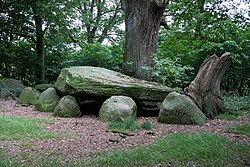Pagan sacrificial table
| Pagan sacrificial table | ||
|---|---|---|
|
The heathen sacrificial table (2009) seen from the north |
||
|
|
||
| Coordinates | 52 ° 52 '34.2 " N , 8 ° 15' 56" E | |
| place | Visbek , Lower Saxony , Germany | |
| Emergence | 3500 to 2800 BC Chr. | |
| Sprockhoff no. | 974 | |
The Heidenopfertisch megalithic system with the Sprockhoff number 974 is located in the municipality of Visbek in the Vechta district in Lower Saxony . It belongs to the facilities of the Wildeshauser Geest and is one of the most famous large stone graves in northern Germany . The complex is on the street of the megalithic culture . The name heathen sacrificial table comes from the 19th century.
The sacrificial table is a megalithic system of the Neolithic funnel cup culture (TBK) (3500–2800 BC). Neolithic monuments are an expression of the culture and ideology of Neolithic societies. Their origin and function are considered to be the hallmarks of social development.
location
The Heidenopfertisch is located near the Autobahn 1 southeast of Ahlhorn at the Engelmannsbäke country inn , in the area of the Endel farmers in the Visbek community .
description
The system in east-west direction is laid out without a border; an overhang is not detectable. There used to be seven bearing stones on one long side and six on the other. Two of the three cap stones are still present. The Heidenopfertisch has the largest and heaviest surviving capstone of all the large stone graves in Oldenburg: with a size of around 5 m × 3 m, the relatively flat capstone should have a weight of around 40 tons. It was originally significantly larger (7.0 m × 3.0 m × 1.2 m), because at least two pieces were blasted off in the early 19th century and used as building material. The burial chamber is approximately 10.0 mx 2.5 m and there is no evidence of an enclosure. The entrance , from which no stones have been preserved, was probably in the western part of the south side.
See also
literature
- Anette Bußmann: Stone Age witnesses. Travel to the prehistory of northwest Germany. Isensee Verlag, Oldenburg 2009, ISBN 978-3-89995-619-1 , pp. 87-88.
- Mamoun Fansa : Great stone graves between Weser and Ems (= archaeological messages from northwest Germany . Supplement 33). 3rd revised edition. Isensee Verlag, Oldenburg 2000, ISBN 3-89598-741-7 , pp. 138-139.
- Ernst Sprockhoff : Atlas of the megalithic tombs Germany . Part 3: Lower Saxony - Westphalia . Rudolf Habelt Verlag, Bonn 1975, ISBN 3-7749-1326-9 , pp. 143-144.
Web links
- Navigator - interactive focused on the heathen sacrificial table. Official map service of the LGLN
- Heidenopfertisch steinzeitreise.de
- Megalithic tombs and menhirs in Lower Saxony
- Large stone graves from the Neolithic Age. Ahlhorn umzu
- Ludwig Strackerjan: Hünensteine in Oldenburg . In: The Gazebo . Issue 7, 1879, pp. 119–123 ( full text [ Wikisource ]).
Individual evidence
- ↑ J. Müller. In: Varia neolithica , VI, 2009, p. 15
- ↑ Pagan sacrificial table . steinzeugen.de; accessed on October 27, 2014


